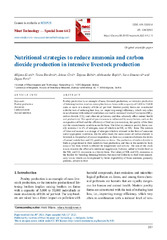Prikaz osnovnih podataka o dokumentu
Nutritional strategies to reduce ammonia and carbon dioxide production in intensive livestock production
| dc.creator | Krstić, Miljana | |
| dc.creator | Đorđević, Vesna | |
| dc.creator | Ćirić, Jelena | |
| dc.creator | Baltić, Tatjana | |
| dc.creator | Bajčić, Aleksandar | |
| dc.creator | Simunović, Sara | |
| dc.creator | Perić, Dejan | |
| dc.date.accessioned | 2024-03-22T10:16:05Z | |
| dc.date.available | 2024-03-22T10:16:05Z | |
| dc.date.issued | 2023 | |
| dc.identifier.issn | 2466-4812 | |
| dc.identifier.uri | https://vet-erinar.vet.bg.ac.rs/handle/123456789/3769 | |
| dc.description.abstract | of fattening broilers involves raising broilers on farms with a capacity of 5,000 to 50,000 units or more at a density of 0.06 m2 per bird. Modern poultry farms are constructed with the task of reducing heat loss, i.e. improving energy efficiency, which very often in combination with reduced ventilation can lead to increased levels of ammonia (NH3), carbon dioxide (CO2) and other air pollutants, and thus adversely affect animal health and productivity. The speed of gas emissions is influenced by many factors, such as the composition of feed and the efficiency of feed use (conversion), the quality of the litter and the microclimatic conditions on the farm. The litter on intensive poultry farms usually contains 4 to 6% of nitrogen, most of which is in NH3 or NH4 + form. The mixture of litter and manure is a storage of nitrogen which is released in the form of ammonia under appropriate conditions. On the other hand, the main source of carbon dioxide in livestock is the product of animal respiration, so there is a connection between the levels of animal metabolism and CO2 production on farms. The production of carbon dioxide in birds is proportional to their metabolic heat production, and thus to the metabolic body mass of the bird, which is affected by temperature and activity. The aim of the study was to examine the effect of a nutritional supplement, Eubiotic, added to broiler feed on the NH3 and CO2 emissions in a broiler farm. The values of NH3 and CO2 emissions in the facility for breeding fattening broilers that received Eubiotic in feed were numerically lower, which can be explained by better digestibility of basic nutrients, primarily proteins, present in feed. | sr |
| dc.language.iso | en | sr |
| dc.publisher | Institute of Meat Hygiene and Technology | sr |
| dc.relation | info:eu-repo/grantAgreement/MESTD/inst-2020/200050/RS// | sr |
| dc.rights | openAccess | sr |
| dc.rights.uri | https://creativecommons.org/licenses/by/4.0/ | |
| dc.source | Meat Technology | sr |
| dc.subject | Poultry production | sr |
| dc.subject | Ammonia | sr |
| dc.subject | Carbon dioxide | sr |
| dc.subject | Animal nutrition | sr |
| dc.title | Nutritional strategies to reduce ammonia and carbon dioxide production in intensive livestock production | sr |
| dc.type | article | sr |
| dc.rights.license | BY | sr |
| dc.citation.volume | 64 | |
| dc.citation.issue | 2 | |
| dc.citation.spage | 387 | |
| dc.citation.epage | 391 | |
| dc.identifier.doi | 10.18485/meattech.2023.64.2.74 | |
| dc.identifier.fulltext | http://veterinar.vet.bg.ac.rs/bitstream/id/11281/bitstream_11281.pdf | |
| dc.type.version | publishedVersion | sr |

